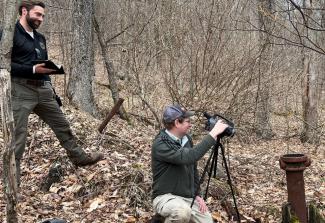NETL experts have hit the road to develop best practices to find and characterize undocumented orphaned oil and gas wells, which can leak methane, a potent greenhouse gas, contaminate groundwater and create other environmental issues after they are abandoned or taken out of production.
“Our most recent effort has focused on a challenging 300-acre site near Olean in western New York. So far this year, our team has made three visits to the site to complete fieldwork that verifies well locations and measures the amount of greenhouse gas they emit,” said Natalie Pekney, Ph.D., the Lab’s lead natural gas infrastructure emissions quantification researcher.
Pekney and her colleagues were asked to undertake their study by the New York Department of Environmental Conservation (DEC), whose oil and gas database contains records for approximately 2,400 confirmed abandoned wells, many of which have fallen into advanced states of disrepair. Undocumented wells, for which no public records exist, are added to the database when they are discovered by landowners, the public, DEC or other agencies.
NETL’s research has important implications beyond the Empire State. Pekney said the Olean study will help the team as it undertakes its latest research mandate — establishing best practices for finding undocumented orphaned wells throughout Appalachia, a region that spans 206,000 square miles from New York to northern Mississippi.
The Bipartisan Infrastructure Law (BIL), signed by President Biden on Nov. 15, 2021, prioritized efforts to locate these wells, determine their levels of methane emissions, wellbore integrity and overall environmental impacts so they can be prioritized for plugging and remediation activities by state and federal agencies. BIL funding includes $30 million to establish a research consortium aimed at developing technologies to achieve these goals. NETL is one of five national labs in the consortium.
The investment is also part of the Administration’s overall response to remediating environmental issues, addressing legacy pollution harming communities, creating good-paying jobs and advancing long-overdue environmental justice.
To launch their investigation in Olean, the NETL researchers reviewed data previously collected by Binghamton University, which had conducted a drone-based survey of the site.
Magnetometers placed on drones can pick up magnetic signals from a well’s metal casing to produce a map. Using the university data, historic maps and records, NETL conducted a boots-on-the-ground investigation to verify well locations and measure their methane emissions. The site features steep elevation changes and is heavily wooded. Portions of the NETL research were dedicated to determining optimal grid patterns that drones need to complete to produce accurate magnetic survey maps over challenging terrain.
Most of the wells at the Olean site were drilled between the 1920s and 1940s. The teams found 63 wells. Low leakages of methane were identified at four wells. “They were not the ‘super emitters’ we’ve seen in other locations,” Pekney said. “However, having their emissions rates is critical so that New York officials can prioritize which wells to plug and make decisions to use resources for maximum impact.”
NETL also deployed advanced technologies to measure greenhouse gas emissions from the wells. The Lab has developed new approaches in continuous monitoring to understand how emission levels change at night or respond to changes in barometric pressure and weather conditions.
Upcoming fieldwork projects for the NETL team include locating and measuring emissions from wells within the Daniel Boone National Forest, which spreads across 21 counties in eastern Kentucky.
The team has worked extensively with state officials to find abandoned wells in Oil Creek State Park near Titusville, Pennsylvania, document their locations and determine if they leak methane and other gases. The park is located at the site of the first commercial oil well, which was drilled by Edwin Drake in 1859.
Drake’s success triggered an oil boom, but its impact on the landscape and environment was devastating. Over time the Oil Creek Valley has returned to its natural, forested state. However, despite significant restoration efforts, hundreds of abandoned oil wells remain in the area.
Pekney said finding abandoned wells, many of which were drilled before environmental laws were enacted and were never documented on public maps and records, is of significant importance.
“Old wells can leak methane. Plus, the soil around these old wells can be unstable, which poses a significant safety threat,” she said.
NETL is a U.S. Department of Energy national laboratory that drives innovation and delivers technological solutions for an environmentally sustainable and prosperous energy future. By leveraging its world-class talent and research facilities, NETL is ensuring affordable, abundant and reliable energy that drives a robust economy and national security, while developing technologies to manage carbon across the full life cycle, enabling environmental sustainability for all Americans.




